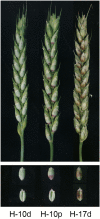Two transcription factors TaPpm1 and TaPpb1 co-regulate anthocyanin biosynthesis in purple pericarps of wheat
- PMID: 29562292
- PMCID: PMC5920291
- DOI: 10.1093/jxb/ery101
Two transcription factors TaPpm1 and TaPpb1 co-regulate anthocyanin biosynthesis in purple pericarps of wheat
Abstract
Purple pericarps of bread wheat (Triticum aestivum L.) are a useful source of dietary anthocyanins. Previous mapping results indicated that the purple pericarp trait is controlled by two complementary genes located on chromosomes 7D and 2A. However, the identity of the genes and the mechanisms by which they regulate the trait are unknown. In this study, two transcription factors were characterised as anthocyanin activators in purple pericarps: TaPpm1 (purple pericarp-MYB 1) and TaPpb1 (purple pericarp-bHLH 1). Three non-functional variants were detected in the coding sequence of TaPpm1 from non-purple seed lines, in which the function of TaPpm1 was destroyed either by insertion-induced frame shifts or truncated peptides. There were six 261-bp tandem repeats in the promoter region of TaPpb1 in the purple-grained varieties, while there was only one repeat unit present in the non-purple varieties. Furthermore, using yeast two-hybrid, dual luciferase, yeast one-hybrid, and transient assays, we were able to demonstrate that the interaction of TaPpm1 and TaPpb1 co-regulates the synthesis of anthocyanin. Overall, our results provide a better understanding of the molecular basis of anthocyanin synthesis in the wheat pericarp and indicate the existence of an integrated regulatory mechanism that controls production.
Figures







Similar articles
-
Purple-grained barley (Hordeum vulgare L.): marker-assisted development of NILs for investigating peculiarities of the anthocyanin biosynthesis regulatory network.BMC Plant Biol. 2019 Feb 15;19(Suppl 1):52. doi: 10.1186/s12870-019-1638-9. BMC Plant Biol. 2019. PMID: 30813902 Free PMC article.
-
Light-Induced TaHY5-7A and TaBBX-3B Physically Interact to Promote PURPLE PERICARP-MYB 1 Expression in Purple-Grained Wheat.Plants (Basel). 2023 Aug 19;12(16):2996. doi: 10.3390/plants12162996. Plants (Basel). 2023. PMID: 37631208 Free PMC article.
-
Transcriptome Analysis of Purple Pericarps in Common Wheat (Triticum aestivum L.).PLoS One. 2016 May 12;11(5):e0155428. doi: 10.1371/journal.pone.0155428. eCollection 2016. PLoS One. 2016. PMID: 27171148 Free PMC article.
-
Purple Wheat: Food Development, Anthocyanin Stability, and Potential Health Benefits.Foods. 2023 Mar 23;12(7):1358. doi: 10.3390/foods12071358. Foods. 2023. PMID: 37048178 Free PMC article. Review.
-
Rising Demand for Healthy Foods-Anthocyanin Biofortified Colored Wheat Is a New Research Trend.Front Nutr. 2022 May 9;9:878221. doi: 10.3389/fnut.2022.878221. eCollection 2022. Front Nutr. 2022. PMID: 35634383 Free PMC article. Review.
Cited by
-
Identification of CmbHLH Transcription Factor Family and Excavation of CmbHLHs Resistant to Necrotrophic Fungus Alternaria in Chrysanthemum.Genes (Basel). 2023 Jan 20;14(2):275. doi: 10.3390/genes14020275. Genes (Basel). 2023. PMID: 36833202 Free PMC article.
-
An OsKala3, R2R3 MYB TF, Is a Common Key Player for Black Rice Pericarp as Main Partner of an OsKala4, bHLH TF.Front Plant Sci. 2021 Oct 29;12:765049. doi: 10.3389/fpls.2021.765049. eCollection 2021. Front Plant Sci. 2021. PMID: 34777449 Free PMC article.
-
Purple-grained barley (Hordeum vulgare L.): marker-assisted development of NILs for investigating peculiarities of the anthocyanin biosynthesis regulatory network.BMC Plant Biol. 2019 Feb 15;19(Suppl 1):52. doi: 10.1186/s12870-019-1638-9. BMC Plant Biol. 2019. PMID: 30813902 Free PMC article.
-
mRNA-miRNA analyses reveal the involvement of CsbHLH1 and miR1446a in the regulation of caffeine biosynthesis in Camellia sinensis.Hortic Res. 2023 Dec 29;11(2):uhad282. doi: 10.1093/hr/uhad282. eCollection 2024 Feb. Hortic Res. 2023. PMID: 39686959 Free PMC article.
-
Flavonoid Biosynthesis Genes in Triticum aestivum L.: Methylation Patterns in Cis-Regulatory Regions of the Duplicated CHI and F3H Genes.Biomolecules. 2022 May 11;12(5):689. doi: 10.3390/biom12050689. Biomolecules. 2022. PMID: 35625617 Free PMC article.
References
-
- Bagge M, Xia X, Lübberstedt T. 2007. Functional markers in wheat. Current Opinion in Plant Biology 10, 211–216. - PubMed
-
- Bartłomiej S, Justyna RK, Ewa N. 2012. Bioactive compounds in cereal grains – occurrence, structure, technological significance and nutritional benefits – a review. Food Science and Technology International 18, 559–568. - PubMed
-
- Baudry A, Caboche M, Lepiniec L. 2006. TT8 controls its own expression in a feedback regulation involving TTG1 and homologous MYB and bHLH factors, allowing a strong and cell-specific accumulation of flavonoids in Arabidopsis thaliana. The Plant Journal 46, 768–779. - PubMed
-
- Baudry A, Heim MA, Dubreucq B, Caboche M, Weisshaar B, Lepiniec L. 2004. TT2, TT8, and TTG1 synergistically specify the expression of BANYULS and proanthocyanidin biosynthesis in Arabidopsis thaliana. The Plant Journal 39, 366–380. - PubMed
Publication types
MeSH terms
Substances
LinkOut - more resources
Full Text Sources
Other Literature Sources

